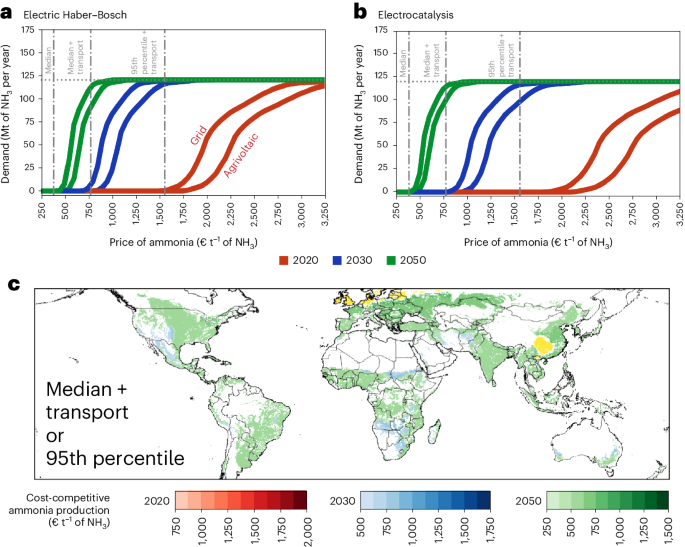
Small-scale decentralized ammonia production could become cost-competitive by 2030
- Select a language for the TTS:
- UK English Female
- UK English Male
- US English Female
- US English Male
- Australian Female
- Australian Male
- Language selected: (auto detect) - EN
Play all audios:

With centralized production, the price of ammonia-based fertilizers is affected by the volatility of the fossil fuel market, complex supply chains and long-distance transportation costs.
Now, an analysis of the cost-competitiveness of decentralized low-carbon ammonia production suggests that a substantial fraction of the global ammonia demand could be cost-competitively
supplied by small-scale technologies by 2030. Access through your institution Buy or subscribe This is a preview of subscription content, access via your institution ACCESS OPTIONS Access
through your institution Access Nature and 54 other Nature Portfolio journals Get Nature+, our best-value online-access subscription $29.99 / 30 days cancel any time Learn more Subscribe to
this journal Receive 12 digital issues and online access to articles $119.00 per year only $9.92 per issue Learn more Buy this article * Purchase on SpringerLink * Instant access to full
article PDF Buy now Prices may be subject to local taxes which are calculated during checkout ADDITIONAL ACCESS OPTIONS: * Log in * Learn about institutional subscriptions * Read our FAQs *
Contact customer support REFERENCES * Rosa, L. & Gabrielli, P. Energy and food security implications of transitioning synthetic nitrogen fertilizers to net-zero emissions. _Environ. Res.
Lett._ 18, 014008 (2023). THIS ARTICLE ANALYSES THE NITROGEN DEMAND FOR CROP PRODUCTION AND ITS LINK WITH THE GLOBAL TRADE OF NATURAL GAS. Article ADS CAS Google Scholar * Smith, C.,
Hill, A. K. & Torrente-Murciano, L. Current and future role of Haber–Bosch ammonia in a carbon-free energy landscape. _Energy Environ. Sci._ 13, 331–344 (2020). THIS ARTICLE ANALYSES THE
CURRENT HABER–BOSCH TECHNOLOGY AND POTENTIAL ALTERNATIVES BASED ON A TECHNO-ECONOMIC POINT OF VIEW. Article Google Scholar * Gao, Y. & Cabrera Serrenho, A. Greenhouse gas emissions
from nitrogen fertilizers could be reduced by up to one-fifth of current levels by 2050 with combined interventions. _Nat. Food_ 4, 170–178 (2023). THIS ARTICLE MAPS THE GREENHOUSE GAS
EMISSIONS FROM ACROSS THE LIFE CYCLE OF SYNTHETIC NITROGEN FERTILIZERS. Article PubMed Google Scholar * Srivastava, N. et al. Prospects of solar-powered nitrogenous fertilizers. _Renew.
Sustain. Energy Rev._ 187, 113691 (2023). A REVIEW ARTICLE THAT ANALYSES THREE MAIN PATHWAYS FOR RENEWABLE-BASED FERTILIZER PRODUCTION AND HIGHLIGHTS THE IMPACT OF TRANSPORT COSTS ON
FERTILIZER PRICES AT THE DEMAND POINT. Article CAS Google Scholar * Comer, B. M. et al. Prospects and challenges for solar fertilizers. _Joule_ 3, 1578–1605 (2019). A REVIEW ARTICLE THAT
HIGHLIGHTS THE ADVANTAGES OF THE DECENTRALIZED, SOLAR-BASED PRODUCTION OF FERTILIZERS. Article CAS Google Scholar * Hunter, J. D. Matplotlib: a 2D graphics environment. _Comput. Sci.
Eng._ 9, 90–95 (2007). Article Google Scholar * Jordahl, K. et al. geopandas/geopandas: v0.8.1. _Zenodo_ https://doi.org/10.5281/zenodo.3946761 (2020). Download references ADDITIONAL
INFORMATION PUBLISHER’S NOTE Springer Nature remains neutral with regard to jurisdictional claims in published maps and institutional affiliations. THIS IS A SUMMARY OF: Tonelli, D. et al.
Cost-competitive decentralized ammonia fertilizer production can increase food security. _Nat. Food_ https://doi.org/10.1038/s43016-024-00979-y (2024). RIGHTS AND PERMISSIONS Reprints and
permissions ABOUT THIS ARTICLE CITE THIS ARTICLE Small-scale decentralized ammonia production could become cost-competitive by 2030. _Nat Food_ 5, 467–468 (2024).
https://doi.org/10.1038/s43016-024-00991-2 Download citation * Published: 16 May 2024 * Issue Date: June 2024 * DOI: https://doi.org/10.1038/s43016-024-00991-2 SHARE THIS ARTICLE Anyone you
share the following link with will be able to read this content: Get shareable link Sorry, a shareable link is not currently available for this article. Copy to clipboard Provided by the
Springer Nature SharedIt content-sharing initiative
